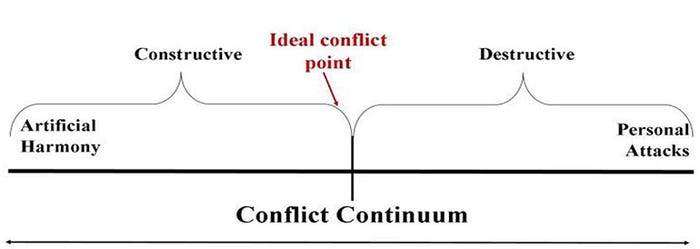Moving conflict from destructive to constructive
Conflict can help us all see growth and create opportunities because ultimately, the worst thing to do is ignore conflict altogether.
April 8, 2020

We have all experienced conflict in our lives, either with a sibling, parent, spouse, friend or coworker. A common way that conflict is addressed is by not dealing with the conflict at all. This leads to even bigger problems within teams and companies.
Not dealing with conflict causes your employees to become less engaged. Work performance will start to decrease and in other cases create turnover. Teams that fear conflict will have more boring team meetings, work in environments where personal attacks thrive, and they will fail to tap into the perspectives of their team members.
But when teams engage in healthy conflict, they will have lively interesting meetings, solve problems quickly and will discuss critical topics.
Who would have thought that conflict was healthy? Patrick Lencioni talks about conflict on a continuum scale. In Figure 1, on one side, you have constructive conflict and on the other end destructive conflict. Ranging from artificial harmony, where everyone pretends that everything is always great and agree on everything. At the other end of the continuum are personal attacks that have nothing to do with the issues at hand.

It isn't possible for a company to always be at an ideal conflict point; having healthy conflict should be the goal. Anyone within a company should feel that they can openly disagree with anyone else in the company with the expectation that it is done in a respectful manner.
Since we all think and react differently, we may be causing conflict unknowingly. In Figure 2, the DISC model is displayed with some of the typical characteristics of each type. Each style has a different way of managing tough situations and those are detailed here.

High D styles tend to seek out problems and solve them as quickly as possible. This style can be quick to anger, but they want to get those solutions resolved and fast.
Low D styles are not as short-fused as their higher counterparts, and they do offer some collaborative solutions to problem-solving.
High I styles are very optimistic and trusting and are not fans of conflict at all. They want a fast resolution to the issues and are bothered by the negativity.
Low I styles can come across as pessimistic and moody and are not as likely to make small talk with others, which can be perceived differently from other styles and cause potential conflict.
High S styles tend to be non-emotional, which can put out the wrong impression when dealing with conflict. They thrive in team environments but can keep their stress hidden and may not vocalize their frustrations and keep them bottled up. This type could hold grudges and resist change.
Low S styles wear their heart on their sleeve. They are very expressive with their emotions and can be very impatient. They will likely be the ones who are most affected by conflict.
High C styles possess fear as their emotion, and they are not risk-takers. These detail-oriented people are cautious and worrisome. They need things to be systematic, and conflict could throw a wrench in their order. They may not verbalize their feelings as openly, which can cause them to burn out if the problem is not addressed timely.
Low C styles are risk-takers who have less fear than high C styles. They tend to do things and ask for forgiveness later, which can create lots of conflicts because they can go and do things "their way."
There are five approaches to conflict resolution. These resolutions need to be chosen based on the specific group and conflict that you are faced with. You may have to use multiple strategies to find the correct resolution for the problem at hand.
Avoiding: This is when nothing is done to address the problem at hand and results in nothing being resolved. When issues are not handled, this only makes them more serious in the long run. Even the smallest concern should be addressed and some solutions applied.
Competing: This is used by people who enter into a conflict situation with a plan to win. These people are often assertive and not very cooperative. The assumption with this resolution is that one side wins when actually everyone loses. This may work best in sports, but in the workplace, for group problems, this is not an effective method.
Accommodating: This is where one party gives in to the wishes and demands of another. They are cooperative but not assertive. This can be effective if one sees that they have been wrong on their end of an argument, not just to merely preserve harmony. Like avoidance, it can result in unresolved issues. Too much accommodation can result in groups where the assertive parties take over and control the conversations.
Collaborating: This is used when people are both assertive and cooperative. Here everyone can contribute with the opportunity of co-generating a solution that the entire group can approve.
Compromising: Here, participants are somewhat assertive and cooperative. Here the concept is a "split-the-difference" approach, where everyone gives up a little of what they want, and no one gets everything that they want. In the end, when compromising is the resolution for conflict, everyone gives a little to reach a single outcome, even if they are not 100% in favor of it.
Henry Ford stated, "Coming together is the beginning. Keeping together is progress. Working together is success."
All of us must work with people in one way or another. We either directly oversee, work alongside, interact with, or talk to others daily. Knowing our communication styles can allow us to understand how we come across to others, but also how we best resolve conflict. Knowing these critical pieces about ourselves will help us to navigate through our professional and personal lives with more awareness and ease. Conflict is inevitable, but when addressed in a healthy way, it can help us all see growth and create opportunities because ultimately, the worst thing to do is ignore conflict altogether.
Summit SmartFarms is devoted to creating irresistible places to work in agriculture by simplifying the complex for labor and technology. If you would like to learn more about how Summit SmartFarms can help your organization, contact Sheldon or Duttlinger.
Sources: Kasey Sheldon and Valerie Duttlinger, who are solely responsible for the information provided, and wholly own the information. Informa Business Media and all its subsidiaries are not responsible for any of the content contained in this information asset. The opinions of these writers are not necessarily those of Farm Progress/Informa.
You May Also Like



